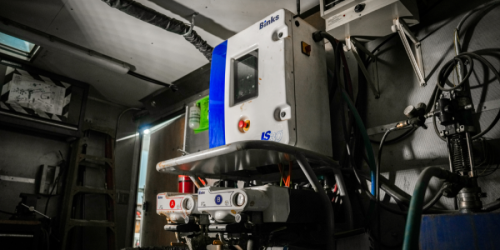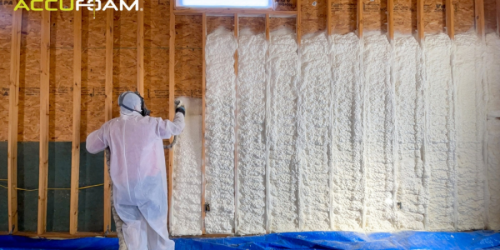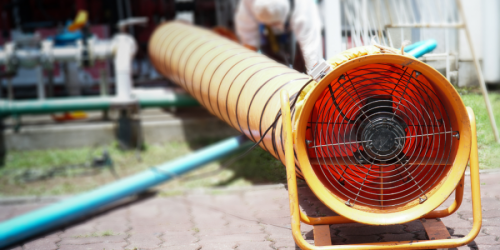Q&A Forums
0.8 pound R-4.5 open cell? Post New Topic | Post Reply
| Author | Comments |
|---|---|
|
John Shockney
Posted: Dec 22, 2010 10:59 PM
|
0.8 pound R-4.5 open cell?
Mason have you heard of an .8 pound open cell that tests at R-4.5 per inch?How can they get higher R-values with air as the primary insulator? Has it passed all the testing? Who is supplying this product? I just had a customer ask for this product (a competitor is offering it) but non of the name brand suppliers that I use (BASF, Bay Systems, LaPola,…) offer anything like this. Thanks Airpro |
|
jimcoler
I have over 10 years of experience specifying and installing open and closed cell spray foam. I've sold my business but I'm still selling for the new owners and consulting on large and custom specific jobs. I've expanded my knowledge into t Posted: Dec 22, 2010 11:03 PM
|
I've heard about this. I saw it at the SPFA trade show last time. Can't remember their name but they had a .5, .8, 1.0, 1.2, 1.7, 2.0, etc. I don't remember their name because they weren't very big and I've heard some other things about them having trouble with paying bills and keeping customers. |
|
quentin
Posted: Dec 23, 2010 09:55 AM
|
I had someone ask about it too. It is a Demilac product. Of course the yield isn't nearly as good as a result and I looked at it for the customer. In the end, you might as well go to a closed cell instead when you look at the cost/yields and etc. |
|
steven argus
Posted: Dec 23, 2010 10:41 AM
|
We've used a 1#, 1.2# and we will try the .8# very soon. We only use it 2 x 6 stud bays to avoid trimming and making trips to the dump. If you add in the extra labor for trimming .5#, dump fees and your crew whinning and grumbling about the trimming, it's a no brainer. I figure we shave off at least 1 full day, maybe 2, of labor/whinning on a typical 2500SF house. |
|
mason
Posted: Dec 23, 2010 11:34 AM
|
There are a few foams being marketed that I call the "tweener" foams; greater than 1/2 lb foam but less than 1.5 lb density foam. We don't have a lot of field history on the foams or an industry based set of standards for the physical properties of the foam. I am conducting my own research on the foams, by reaching out to the suppliers of the products to gain more understanding of how they perform over time in a variety of climates and applications. As chairman of ASTM C 1029, Standard for Closed Cell SPF and a member of the ASTM Low Density standard Task Force for developing that standard, I have a duty to help determine how those materials should be categorized and to help determine the viability of the products. In the meantime, I don't have enough experience with them to provide good information for those that want to use the foams. I would appreciate any feed back from folks that have used them. Send detailed info to masonknowles@aol.com |
|
John Shockney
Posted: Dec 23, 2010 10:46 PM
|
I still don’t understand how you can get an R-value over 3.8 per inch when it is an open cell foam and air is the primary insulator in the foam. I have heard of some 1.2 pound water blown foams that some of the cells remain closed and under a partial vacuum giving it higher R-values. So what is the advantage to spray these foams? They can’t have higher R-values unless you are rewriting the laws of physics. I would like to see the independent testing that confirms their claims and their ICC ESS report before selling these products. Thank you for your help Airpro |
|
jimcoler
I have over 10 years of experience specifying and installing open and closed cell spray foam. I've sold my business but I'm still selling for the new owners and consulting on large and custom specific jobs. I've expanded my knowledge into t Posted: Dec 24, 2010 08:15 AM
|
SO, how does filterglass get to an R-4.1 or even higher? Yes, I said that correctly!! I've seen it in the big box stores for sale and calculated out the R-value per inch of the filterglass and it's between 3.9 and 4.7!!!!This is only air that passes through the filterglass too! I'd like to see the testing results on these products too! But, when you ask for the testing results from the manufacturer, they say there not available!!!How convenient!! |
|
Richard Russell
Posted: Jan 08, 2011 11:02 AM
|
Truly dead air has a thermal conductivity that translates to just about R 6.0 per inch. Any porous insulation depends on trapping tiny pockets of dead air. If the thermal conductivity of the solid material (fibers or walls of foam cells) is greater than that of the trapped air, then the effective R of the insulation layer is reduced. The problem with any such insulation is making the air pockets as truly "dead" as possible. Any convective flow through the layer of insulation cuts its effective R value. Increasing the density of a porous insulation tends to reduce convective flow and thus increase total R, but offsetting this somewhat is the increased volume fraction of solid material with higher thermal conductivity. In the case of a closed cell foam, the isolation of the gas bubbles is essentially complete. If the gas trapped within the foam is not air, but something with a lower thermal conductivity, then the R of the insulation layer is improved, but is slowly diminished as the gas diffuses out and is replaced by air diffusing in over time (the "aging" effect). Further, the low permeability of the foam material gives the closed cell foam low enough permeability to achieve "vapor retarder" status in a relatively thin layer. |
|
jimcoler
I have over 10 years of experience specifying and installing open and closed cell spray foam. I've sold my business but I'm still selling for the new owners and consulting on large and custom specific jobs. I've expanded my knowledge into t Posted: Jan 08, 2011 05:26 PM
|
Your talking about conduction heat transfer and missing my point abouty convection, radiant heat transfer and thermal mass! Where are these measured??? Check out the Making SPF better link/forum which has more on this. |
|
JohnPeters
Posted: Jan 25, 2011 10:12 PM
|
Demilec has ICC-ES report for their 0.8 lb product. Its legit. There is a direct correlation between yield and density. R-value is a component of that equation as well - maybe not so linear. With 0.5 lb you get 15 - 16.5k yield with R-values between R-3.6 to 3.9. With the "tweeners" you get 11-13k yield with R-values between R-4.3 to 5.0. What is not to get? What is the question? |
|
John Shockney
Posted: Jan 26, 2011 04:19 PM
|
John The only reason I question this is the physics and science involved. Based on kinetic theory and how heat moves though matter. Energy in the form of heat travels faster through solids (even plastics) than through gases. So if you increase the density of the foam you are adding more solids and the R-value should actually go down unless you replace the gas with one of lower density like the Argon used in windows or the blowing agent used in closed cell foam. Or have the air trapped in closed cells under a partial vacuum, as is the case in some of the water blown closed cell foams. Again I am just trying to understand how they are getting these higher R-values or is it just like the fiberglass manufactures and they are setting the test up so it shows their product to be better than it really is. Airpro |
|
JohnPeters
Posted: Feb 02, 2011 12:03 PM
|
Then why does water blown closed cell (1.7lb to 2.0lb) have an R-value of R-5 and up? Or 1.0lb open cell have an R-value of R-5? Based on your analysis of the thermodynamic properties of cellular plastic, the R-value of OC foam insulation should start going down above 0.5 lb density?! That doesn't make sense. Density does not have a diminishing effect on the R-value of polyurethane until you get into the 2.5 lb density range. Obviously blowing agent effects this. Hence roofing foam systems typically have R-values of R-6 per 1" and 2.0 lb cavity fill can reach R-7 per 1". They use 245fa too, but because of increased density thermal resistance is reduced. Talk to any chemist and ask them why the entire industry makes a 0.5 lb foam. You will get 20 different answers. To me, the reason the industry fixated on 0.5lb is because of icynene and demilec set the marketing standard. High yeild, with slightly better R-value than fiberglass (which was the standard). o.5lb wasn't the density of choice because it is the magic point where R-value is the highest for an open cell foam. Quite simply, they are getting higher R-value because the product is denser. There is no trickery here. No wool over your eyes - and definitely has nothing to do with FG manufacturers getting more R-value out of their products. We need some Mason knowledge here. |
|
mason
Posted: Feb 02, 2011 01:13 PM
|
I hesitated to jump in on the discussion so as not to take sides. But, the insulation value of a product is based on a number of factors. Density is not as important as a few other factors. 1. Size and number of foam cells. The more foam cells and the smaller the size, the better the insulation value regardless of the blowing agent use and whether it is open or closed cell foam. Note; you are likely to get smaller size cells and more foam cells when the foam is mixed very well. So, the spraygun configuration and proportioner heat and pressure can affect this item considerably. A sprayfoam manufacturer should take this into account when making samples for R value tests. 2. Blowing agent type. Yes, HFC, hydrocarbon, HCFC, CFC blowing agents have greater insulation value than water or carbon dioxide blowing agents. 3. Resistance to radiation. The foam cell configuration may have an effect on the conduction rate of heat transfer for the foam. Again the smaller size foam cells will work better in this regard as well. I think this is the reason you have such varying degrees of R value within foams with similar blowing agent packages. And yes it does explain how you can get higher R values with a higher density open cell foam even if it uses water as its blowing agent. The same concept can explain how fiberglass can have greater R value with a higher density product. The higher density product has a smaller and greater number of air pockets within the fiberglass matrix. The source of my information is from Mark Bomberg's book "Spray Polyurethane Foam in External Envelopes of Buildings" and research performed by Robert Alumbaugh with the department of the Navy and Dupont's studies of sprayfoam in the 60s and 70s. |





























